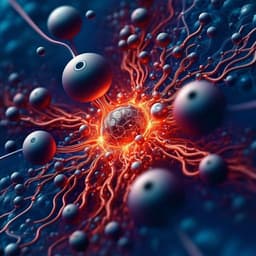
Environmental Studies and Forestry
Turning dead leaves into an active multifunctional material as evaporator, photocatalyst, and bioplastic
S. Fang, X. Lyu, et al.
This innovative research by Siyuan Fang, Xingyi Lyu, Tian Tong, Aniqa Iban Lim, Tao Li, Jiming Bao, and Yun Hang Hu reveals a groundbreaking method to transform dead leaves into a versatile multifunctional material. The study highlights the potential of this sustainable approach in waste management and advanced material development, showcasing its ability to function as a thermal evaporator, photocatalyst, and bioplastic.
~3 min • Beginner • English
Introduction
The study addresses the challenge of transforming abundant waste dead leaves into valuable materials without destroying their inherent biocomponents. Conventional approaches such as incineration, landfilling, composting, or high-temperature carbonization lead to greenhouse gas emissions, land use issues, long processing times, or high energy consumption. While wood has been successfully reconstructed into high-performance materials via lignin regeneration and structural engineering, leaves—rich in lignocellulose and biominerals—remain underutilized, often being fully carbonized. The research hypothesizes that the often-overlooked biomineral calcium oxalate monohydrate (whewellite) in leaves can act as a strong binder to integrate lignin and cellulose through chemical and hydrogen bonding, enabling the creation of a multifunctional material that retains and leverages leaf biocomponents. The purpose is to develop an “active multifunctional material” (AMM) from red maple dead leaves with capabilities in solar evaporation, photocatalysis, and as a high-temperature-resistant bioplastic, thereby offering environmental and energy benefits and reducing carbon emissions compared to traditional disposal methods.
Literature Review
Prior work on biomass valorization has focused on wood, where structural reconstruction has produced strong, recyclable bioplastics and moldable 3D materials via lignin regeneration and rapid water shock processing. For leaves, efforts have often relied on carbonization to generate carbon materials for adsorption and energy storage applications; however, this fully destroys biostructures and is energy-intensive. Leaf-based adsorbents have been used for heavy metal removal, and biomass-derived carbons have been explored for catalysis and electrochemical devices. A key gap is the neglect of the role of calcium oxalate monohydrate (whewellite), a common leaf biomineral for structural support and calcium storage, in binding and integrating leaf biocomponents. The present work departs from carbonization by leveraging whewellite to bind lignin and cellulose, aiming to retain and synergistically exploit leaf components for multifunctional performance.
Methodology
Raw materials: Dried red maple (Acer rubrum) leaves collected (Houghton, MI, Oct 2021), washed, dried, and ground (<300 μm). Leaves of Cercis canadensis, Quercus rubra, and Acer platanoides were similarly collected for universality tests. Chemicals included choline chloride, oxalic acid dihydrate, Ca oxalate monohydrate, mineral acids/bases, and various metal oxides and sulfides for controls and comparisons.
Synthesis of AMM: A deep eutectic solvent (DES) was formed by mixing 63.0 g choline chloride and 63.0 g oxalic acid dihydrate (1:1 molar) and melting at 80 °C with stirring to a transparent liquid. Leaf powder (8.9 g) was added, heated to 100 °C for 30 min; 31 mL deionized water was introduced, and heating at 100 °C continued for 20 min with magnetic stirring. After cooling, the brown solution was centrifuged (3000 rpm, 10 min, repeated). The resulting black slurry was cast on stainless steel and dried rapidly at room temperature to form AMM films. Yield (dry basis): 57.7%. Lignin was in-situ regenerated and cellulose defibrillated; most pigments and mineral elements were removed. Main components: lignin, cellulose, and whewellite.
Control samples: (i) Lignin–cellulose (minerals removed): leaf powder demineralized in 2 M HCl (100 mL per 1 g leaf) at 70 °C for 3.5 h, washed to neutral pH, dried, then processed via the AMM synthesis route. (ii) Lignin: 1 g leaf treated with 20 mL 2 wt% H2SO4 at RT for 2 h, then 750 mL water, boiled at 100 °C for 4 h, washed and dried. (iii) Cellulose: leaf powder treated with 0.4 M Na2SO3 + 2.5 M NaOH (10 mL) at 100 °C for 3 h, washed, then dispersed in 10 mL 100% H2O2 and boiled at 100 °C for 3 h until colorless, washed and dried. Pressed disks of selected inorganic semiconductors (e.g., TiO2, ZnO, WO3, CeO2, ZrO2, Ga2O3, MoS2, WS2) and whewellite/hydrochar/pyrochlore were prepared for comparisons.
Characterization: XRD (Scintag XDS2000) determined crystalline phases; FT-IR (Shimadzu IRPrestige-21 ATR) and temperature-variable DRIFTS (Shimadzu IRAffinity-1 with in-situ chamber) probed molecular vibrations and thermal evolution; XPS (PHI 5800 C-AX) analyzed surface chemistry; UV–vis–NIR absorption (Lambda UV-2450 and Bomem MB-160) assessed optical properties; SEM (top-view and cross-section) and TEM/HR-TEM with EDS mapping examined morphology and distribution of whewellite nanoparticles within lignocellulose; SAXS at APS 12-ID-C (18 keV, Pilatus2M, ~2.2 m sample-detector) probed nanostructure/isotropy; ICP-OES (Perkin Elmer Optima 7000DV) quantified mineral elements after incineration and acid digestion.
Electrochemical and photophysical analyses: Mott–Schottky (1, 2, 3 kHz in dark) and transient photocurrent response under visible light (λ > 400 nm, 0.58 mW cm−2) using a three-electrode cell (fluorine-doped tin oxide glass coated with PANI as working electrode; saturated calomel reference; appropriate counter; 0.5 M Na2SO4 electrolyte). Time-resolved fluorescence decay measured on a Horiba iHR320 with 400 nm, 150 fs pulse excitation.
Performance testing: Solar water evaporation measured by placing an AMM film (1 g, 3 cm × 3 cm) floating on 20 mL deionized water in a 100 mL beaker under simulated sunlight (Newport 300 W Xe lamp, AM1.5G). Mass loss monitored in real time with an analytical balance (0.1 mg). Surface temperature measured by digital thermometer. Solar-to-steam efficiency calculated using evaporation rate, latent heat of vaporization (−2260 kJ kg−1), and incident intensity.
Photocatalytic H2 production: AMM film (40 mg, 1.5 cm × 1.5 cm) in a quartz reactor with 10 mL of 30 vol% methanol–water. Reactor evacuated, then illuminated with Xe lamp under AM1.5G (1 kW m−2) or visible-only (UV-cut 400 nm, 0.85 kW m−2). H2 quantified by pressure gauge and GC (HP 5890 Series II, Porapak Q, TCD). Cycling by refreshing methanol solution.
Photocatalytic tetracycline degradation: AMM and comparison materials tested under simulated sunlight (1 kW m−2) or visible light (λ > 400 nm, 0.58 kW m−2). Adsorptive removal (Ra) after 30 min dark equilibration and photocatalytic removal (Rp) during illumination were quantified; pseudo-first-order kinetics derived (ln C = ln Cin − kt). Degradation products analyzed by LC–MS and their toxicities estimated using USEPA’s Toxicity Estimation Software Tool.
Mechanical and thermal tests: Films prepared by wet casting and drying. Tensile tests at RT and 100 °C at 3 mm min−1 to fracture (TA Instruments Q800). Dynamic mechanical analysis (30–90 °C, 2 Hz, 5 μm amplitude). Thermogravimetric analysis and in-situ DRIFTS assessed decomposition behavior and chemical changes upon heating.
Biodegradability: Thin films of AMM and daily-use polyethylene plastics (zip bag, shopping bag, plastic wrap) were buried in soil at 10 cm depth and monitored for physical degradation over time.
Key Findings
- AMM formation and composition: From red maple dead leaves via DES (choline chloride + oxalic acid dihydrate), yielding 57.7% (dry basis). The AMM comprises lignin, cellulose, and embedded whewellite (CaC2O4·H2O) nanoparticles intimately contacting lignocellulose.
- Structure and bonding: XRD confirms whewellite and reduced lignocellulose crystallinity post-DES. FT-IR and XPS indicate enriched C–O, C–O–C, and –OH groups forming extensive H-bond networks. DFT shows strong binding energy for lignin–cellulose–whewellite composite (468.9 kJ mol−1), about 25× higher than lignin–cellulose alone (0.19 kJ mol−1), with evidence of hydrogen bonding to oxalate oxygens and Ca–O interactions (~2.5 Å) with lignin/cellulose hydroxyls.
- Morphology and optics: SEM reveals a dense film with a cellulose nanofiber core and distributed lignin flakes and whewellite nanoparticles; rough surface enhances internal photon reflection. SAXS indicates isotropic structure with alignments. UV–vis–NIR spectra show strong, broadband absorption from UV through visible to NIR, far exceeding original leaves; attributed to extended conjugation in lignocellulose.
- Solar water evaporation: High evaporation rate of 0.8 kg m−2 h−1 and solar-to-steam efficiency of 52.5% at 1 kW m−2 (AM1.5G), among state-of-the-art, mainly due to lignocellulose-driven photothermal conversion.
- Photocatalytic hydrogen production: AMM produces H2 from methanol–water mixtures under simulated sunlight (1 kW m−2) and under visible light (λ > 400 nm), supported by time-resolved fluorescence and photocurrent demonstrating effective charge separation and transport.
- Photocatalytic antibiotic degradation: Rapid, visible-light-driven degradation of tetracycline following pseudo-first-order kinetics with large rate constants of 0.028 min−1 (simulated sunlight) and 0.021 min−1 (visible). AMM exhibits superior adsorption and photocatalytic removal efficiencies compared to its constituents (lignin, cellulose, original leaf) and various inorganic semiconductors (e.g., TiO2, ZnO, WO3, CeO2, ZrO2, Ga2O3, MoS2, WS2) and to hydrochar and pyrochlore controls.
- Mechanical performance: AMM shows high tensile strength of 132 MPa, orders of magnitude above original leaf and individual component films. Room-temperature storage modulus reaches 3144 MPa versus 70 MPa for original leaf (~45× higher), indicating markedly enhanced rigidity; retains substantial strength at 100 °C.
- Thermal stability: Decomposition temperature ranges similar to original leaf (≈230–480 °C) but with lower decomposition rates and much higher char residue after pyrolysis (24.4% for AMM vs 6.6% for leaf). In-situ DRIFTS indicates stability up to 230 °C with minimal attenuation of characteristic signals; at 600 °C, lignocellulose C–H bonds break and calcium oxalate converts to CaCO3.
- Biodegradability: AMM becomes brittle and fractures by ~40 days and fully degrades by ~2 months in soil (10 cm depth), while polyethylene controls remain unchanged after 2 months. Proposed mechanisms include fragmentation by fauna, microbial mineralization/humification, and leaching.
- Universality and environmental impact: Approach generalizes to multiple leaf species (Cercis canadensis, Quercus rubra, Acer platanoides) and to both leaf pulp and veins, yielding similar mechanical and functional performance. Life-cycle considerations indicate lower carbon emissions than incineration, landfilling, and composting.
Discussion
The findings validate the central hypothesis that the native leaf biomineral whewellite can serve as a robust binder to integrate lignin and cellulose, forming a dense, heterogeneous composite that preserves and enhances leaf biocomponents without carbonization. Strong chemical (Ca–O) and hydrogen bonding interactions, verified by spectroscopy and DFT, create a stable architecture that promotes charge separation and transport under light, enabling multifunctionality: efficient photothermal conversion for solar evaporation, and effective photocatalysis for hydrogen generation and antibiotic degradation. The broadband optical absorption of the AMM, arising from lignocellulose conjugation and surface roughness, underpins high solar-to-steam efficiency. Mechanically, the consolidated composite confers high tensile strength and stiffness, while thermal analyses show stability up to 230 °C, making AMM viable as a high-temperature-resistant bioplastic. Biodegradability tests demonstrate environmental compatibility relative to persistent polyethylene plastics. The approach generalizes across diverse leaf species and leaf anatomical parts, suggesting scalability and robustness. Collectively, the results address the challenge of valorizing leaf waste into high-value materials, with implications for sustainable waste management, water purification, renewable hydrogen production, and plastic replacement.
Conclusion
The study introduces a strategy to convert dead leaves into an active multifunctional material (AMM) by leveraging whewellite to bind lignin and cellulose, avoiding destructive carbonization. The AMM exhibits strong broadband light absorption, efficient photothermal performance for solar water evaporation, high photocatalytic activity for hydrogen production and antibiotic degradation, and functions as a high-strength, thermally stable, and biodegradable bioplastic. Universality across multiple leaf species and reduced environmental impact relative to conventional leaf disposal highlight its practical potential. Future work could focus on scaling production, optimizing film architecture and thickness for specific applications, quantifying long-term durability in diverse environments, expanding photocatalytic reactions to pure-water H2 evolution, and integrating AMM into modular devices for water purification and environmental remediation.
Limitations
Related Publications
Explore these studies to deepen your understanding of the subject.







